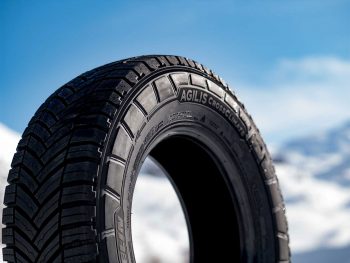Poor road conditions and poor-quality tyres are not a great combination. Matthew MacConnell looks at how fleets can reduce risk of incidents and accidents when faced with driving in bad weather.

Tyres are one of the most important components of your vehicle and the importance of compatible rubber on an organisation’s light commercial vehicles should be carefully considered to minimise risk for fleets. All-season tyres are becoming increasingly popular as they have a harder compound than winter tyres, but are softer than summer tyres. As a result, they are less prone to wear – and more durable. When picking the right tyres for an LCV, it’s important to consider driving conditions, the climate and also performance requirements.
“I spoke to a few ambulance drivers and asked them how they were getting on in bad conditions and not one of them said that the tyres were amazing,” says Michelin’s brand manager, Martin Thompson. “Instead, they thought it was down to the new vehicles they had been given. That really shows how much people think about the four bits of rubber that are getting them about.”
All-season tyres have several advantages over winter sets – storage and all-year usability being just two. Whenever the season changes, fleet maintenance teams no longer need to put the time and effort, into removing older tyres and storing them safely. All-season tyres also offer more grip than summer ones in the winter as well as more grip than winter sets in the summer. There’s a small grade difference between a summer tyre and an all-season tyre that means the fuel trade-off isn’t going to be noticeable for most fleets, either. Snow socks or chains are an additional option if an all-season tyre reaches its limit in snowy conditions, but it’s recommended that snow chain users do not exceed 30mph.
Michelin Tyres offers a damage-resistant all-season tyre with winter capability called the Agilis CrossClimate, which is claimed to be popular among blue light fleets. Meanwhile, Bridgestone recommends its Duravis All Season tyre, which is robust and has an A-grade EU label for wet grip and three-peak mountain snowflake c(3PMSF) certification. The snowflake certification shows that the tyre has reached a minimum standard for positive winter performance.

The Fleetcare Go Plan is Bridgestone’s new premium tyre and vehicle maintenance subscription service for van fleets and is powered by Webfleet telematics. This setup allows fleet managers to have their own personalised portal offering insights into their fleet’s status. Continental’s answer to an all-season tyre is the Generation 5 VanContact A/S Ultra. The tyre features ‘intelligent snow catchers and smart 3D sipes to provide outstanding grip in occasional snowy conditions’, according to the company.
For those who haven’t made the all-season switch, what are the advantages of winter tyres and how do they compare from a risk management point of view to all-season tyres? In cold conditions, winter tyres provide optimal grip and are more effective below 7°C due to their grippy threads alongside the tyre shape and design. It’s again recommended to choose a tyre that has the three-peak mountain snowflake symbol on the sidewall. After installing winter tyres, it’s also recommended that tyre pressure is checked fortnightly, as it tends to drop due to cold air being denser than warm air. As temperatures rise, however, winter tyres will wear faster due to their soft compound and levels of grip will decrease. Michelin technical manager, Brian Porteous, advises that maximum grip should be at the rear of the LCV as this helps stabilise the vehicle. If fleet operators were to fit winter tyres solely to the front of the vehicle, this could result in loss of control.
“Despite well-published information that winter tyres do not perform adequately in warm weather, a surprising number of drivers don’t bother to switch back to summer tyres.”

“Around 43% of European drivers change over to winter tyres for the cold season, with enormous differences by region,” reveals Bridgestone’s technical manager, Gary Powell. “However, despite well-published information that winter tyres do not perform adequately in warm weather, a surprising number of drivers don’t bother to switch back to summer tyres.”
If a fleet does rotate its tyres, companies such as Kwik Fit offer a ‘tyre hotel’ service and can change tyres via a remote unit. Meanwhile, for EV fleets, there are EV-ready solutions available such as the Bridgestone Duravis Van summer tyre. Bridgestone prides its tyre on achieving the highest EU label rating for wet grip and for offering the best-in-class mileage for extended tyre life.
Whether it’s all-season or seasonal sets, it’s worth considering just how much an LCV will be carrying and, therefore, if the tyres may be overloaded. Overloading your tyres can cause poor handling, an increase in fuel consumption, tyre cracking and, in more severe cases, a tyre blowout. In addition, according to a consensus by TyreSafe, 2009 was the year when over 215 motorists were either killed or suffered serious injuries as a result of defective or under-inflated tyres. There were 1,168 accidents recorded where people received minor injuries.
Another related safety issue is overloading the vehicle itself, or exceeding its gross vehicle weight. If the driver is pulled over by the police, they could face a fixed penalty ranging roughly between £100 to £300. If a van is overloaded by 30%, it will most likely result in a court summons where larger fines of £500 to £1500 will be issued. In more severe cases, the van could be impounded, and further fines may be imposed.
In more detail, every motor vehicle carries both kerb weight and gross vehicle weight information. The kerb weight should be located on the LCV’s VIN plate, which can be found on the driver’s side door pillar, under the bonnet or on the front bulkhead. This is stated in kilograms and shows the weight of the vehicle as if it had no passengers and was sat unloaded. The gross vehicle weight, also stated on the VIN plate, tells you how much your vehicle is allowed to weigh before it exceeds its legal limit and is then overloaded. The difference between the two is known as the payload capacity which is the maximum weight the vehicle is allowed to carry in kilograms. If your van is found to be overloaded by 5% – 9.99%, this would result in a £100 penalty, if overloaded by 10% to 14.99%, it’s a £200 penalty and 15% to 29.99% there’s a £300 penalty. If you’re found to be overloaded by up to 29.99%, you won’t receive penalty points, but should a court summons be issued, this could result in a conviction that carries up to 11 points. While your organisation is responsible for ensuring the correct tyres, as per the payload, are fitted to the vehicle, the operator is responsible for ensuring the van is not overloaded.

Brian Porteous, from Michelin, recommends that the selected tyre be the same as the OEM specification, has a sufficient capacity for the load and meet the requirements for that particular LCV. If a fleet has any concern about load ratings, Porteous says Michelin can assist, not only in preventing a possible tyre rupture, but also in helping maximise your tyres’ capability.
While systems are being tested for remote tyre pressure and wear monitoring for LCVs, there are no products available on the market right now – although the vehicle itself may already be equipped with such systems by the manufacturer. Michelin says that physical routine checks are still king and if fleet operators can picture what is normal for their LCV, that can help prevent any potential risk and reduce costs. Measuring tyre wear can be done by using a 20p coin in a main groove; if you can see the outer section of the coin, the tyre is near the legal limit.

